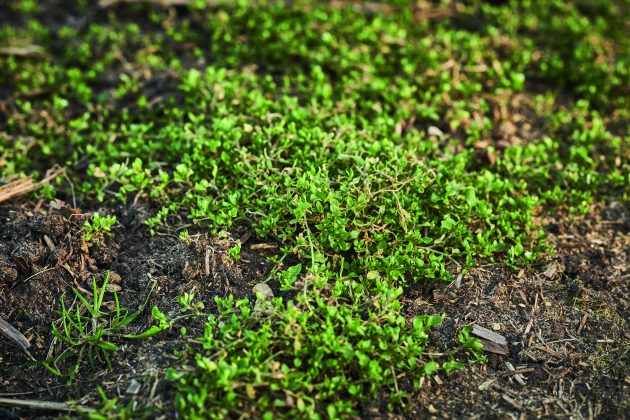While the garden is poised to unleash its greatest glories, many gardeners find themselves absorbed by those plants in the wrong place. Ursula Buchan advises on dealing with the perennial problem of weeds
Ah, the merry month of May. How much we look forward to it, since it always feels like the time of greatest promise in our gardens. You can almost taste the optimism in the air. The late tulips are in full flight, herbaceous perennials are in fresh green clothes. The rhododendrons and azaleas are flowering fit to bust, and there is a hint of the glorious rose floraison to come in the yellow flowers of climbing Rosa banksiae. But what do we gardeners spend our time doing in May? We whinge about the weeds.
It is understandable, I suppose. May is the month when weeds – sorry, plants out of place – begin to impact on our psyches. The May surge of growth, which comes with the longer, warmer days, brings also an explosion of annual and perennial weeds. Annual weeds – speedwell, chickweed, shepherd’s purse, bittercress, groundsel, annual nettle and the like – can blanket our borders if we turn our back for a fortnight or don’t get round to putting down a really thick mulch in spring.
Weeds: plants out of place
But it’s the perennials that cause us the most grief. We can all recite the roll call: perennial nettle, bindweed, ground elder, creeping buttercup, smooth and rough meadowgrass, and dandelion are the ones that grow almost everywhere. My particular bête noire is hedgerow bindweed, Calystegia sepium, whose white trumpet flowers in summer shame me dreadfully. However, the field bindweed, Convolvulus arvensis, isn’t far behind in embarrassment potential. And the white roots of hedge bindweed go down so deep, and are thus so drought resistant, that there really is no hope of ever banishing them completely.

Nettles may be thought of as weeds but are important to many insects
Why can’t we just live with them? Especially in this era of more relaxed, ‘natural’ gardening. After all, stinging nettles in the far reaches of my garden are annually shredded by the caterpillars of peacock butterflies. Even poisonous ragwort is host to the larvae of the beautiful cinnabar moth. The problem we have is that a garden is an artificial construct, not a small parcel of landscape. Most gardens are crammed with non-native plants and thus rarely a match in vigour for native weeds. They have evolved over millennia to like our climate and soil conditions rather more than Californian ceanothus or Himalayan lilies do. And there is a coarseness, a rude energy and a relentlessness about them, which sinks the heart.
Even ragwort hosts the cinnabar moth larvae
I don’t exactly welcome annual weeds but since I bought a brilliantly sharp, short-handled weeding hoe, a comfortable kneeling pad and earbuds, I can happily spend long afternoons cleaning the borders of these weeds. For paving, I use a contact weedkiller, whose main ingredient is either acetic acid or pelargonic acid. Although you should always take care with the use and disposal of garden chemicals, you can see you can’t do much harm, except to green leaves, by spraying a more concentrated garden formulation of the white vinegar used in the house. And the leaves begin to die almost immediately. Weeds in paving cracks don’t like a targeted sprinkling of table salt either, since it causes the cells to collapse through reverse osmosis.
But whatever do we do about those perennial weeds that most threaten to ruin the look of our gardens? Digging up and removing all the roots can work with shallow-rooted ground elder. While suffocating the deep rooters with porous black geotextile, covered with a heavy bark mulch, keeps them from taking over bare ground. In crowded borders, the focused use of glyphosate gel, a ‘systemic’ herbicide, which travels down the plant’s system to the roots, is probably the only realistic option. Plant a 90mm-tall bamboo cane in the ground near to a strand of bindweed, leave it to spiral up, then dab the leaves with the gel.
Don’t allow weeds to dominate gardening pleasure
That said, I do try very hard not to allow weeds to absorb all my thoughts and energy, especially in a month when there is so much to look forward to. Think instead of the flowering of great tribes of hardy geraniums, aquilegias and peonies, and the first broad beans and saladings in the vegetable beds. Not to mention the Chelsea Flower Show, where there is never a plant out of place and the only weeds you’ll find are those that have been put there on purpose.
Click here to read more of The Field‘s gardening features. Are you a novice gardener in search of where to find the best tips and advice? Read Ursula Buchan’s guide for novice gardeners.





